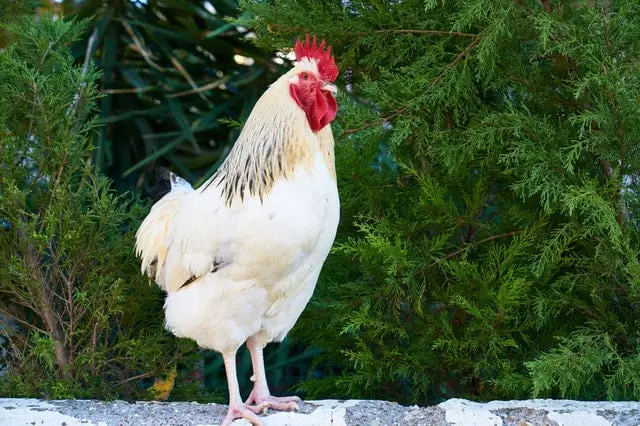
The hen is one of the undisputed protagonists of the history and evolution of man on earth. History documents the first traces of the hen since 4000 BC Raised mainly for the production of meat and eggs, recently its function has also become a companion and ornamental.
Over the centuries, poultry farmers have selected and crossed the most valuable breeds to enhance their characteristics.
This has made it possible to obtain breeds that are particularly appreciated both for the quality of the meat and for the quantity of eggs deposited. But let’s learn all about this animal and discover curiosities and anecdotes that we may not know.
Appearance and characteristics
The domestic hen is a poultry born bird known as Gallus gallus domesticus or Gallus sinae. It is the female of the rooster , which sometimes assumes the role of hen when it hatches the fertilized eggs and raises the chicks .
Unlike the male, the hen has uniform plumage , does not have a noticeable or showy crest and has a smaller and slender physical structure. On the legs it does not have spurs , typical of the rooster, and in the wild it can live up to 10-11 years of age.
Its favorite food is insects, seeds, larvae, lizards and is therefore considered an omnivore. It has no teeth, so it has to ingest food along with pebbles that assist the digestive process and promote a kind of alternative chewing that takes place directly in the stomach .
Usually a hen does not fly , despite having wings, but merely hovering in the air for a few meters. It manages, therefore, to overcome a hedge or a barrier that is not too high, but it will never take flight.
Although popular belief attributes to it a very low IQ, in reality it is an attentive, witty animal, with an excellent spirit of observation. He lives in groups governed by very rigid internal hierarchies. The most authoritative members even take precedence over food and can choose where to lay their eggs.
Breeds of chickens
The hen has different aesthetic, behavioral and functions characteristics depending on the breed to which it belongs . The breeds, in fact, mainly define their size, color and shape . The most important classification of the breeds is that between:
Breeds from eggs
With a light structure, little fat and a large basin. The eggs produced by these hens are used for food consumption and are not fertile, therefore they cannot be used for the reproduction of the species.
Among the most famous egg breeds we remember the Livornese hen , also called Leghorn , which in turn includes many varieties. The most common are: the White Leghorn or white Livornese, the tan, the golden and the fawn. Leghorn hens are also distinguished from others by the color of the eggs they lay.
The shell, in fact, is white , while the hens of other breeds lay eggs with a brownish shell.
Meat breeds
These are hens with a much stronger bone structure and generally more adipose tissues. They are mainly bred for slaughter and in general for food consumption.
Among the breeds bred for meat production are famous those of oriental origin , such as the Brahma , Shanghai and Langsham . The breeding of the broiler hen can be both domestic and industrial.
The new European provisions on breeding have established that hens for broilers can no longer be kept in ‘batteries’ as it is essential to guarantee the animal sufficient space to move freely and lead a dignified life .
Finally, in recent years, there are more and more organic chicken farms where the hens are raised on the ground and fed with feed and grains deriving from organic farming.
Reproduction
Since childhood we have learned that in spring and summer the rooster mates with the hen. The latter lays about 15 fertilized eggs in its nest and, as long as it is not disturbed by anything or anyone, it begins to hatch them to keep them warm for about 3 weeks . At the end of this period the eggs hatch and the chicks peep out from among the feathers of their mother who, in fact, is not a simple hen but takes the name of hen.
The reproduction of the hen, therefore, is oviparous , since both the incubation and the fertilization of the eggs take place internally. A recurring doubt concerns the reproductive organs of the hen and the fact that they are similar to those of mammals.
The answer to this question is obviously no: both in appearance and in functioning the reproductive organs of chickens and hens are very simple and rudimentary.
Following the hatching of the eggs, the young will be cared for by the hen for a few months. During this time, they will live in symbiosis with their mother who will defend and educate them for survival, continuing to keep them warm under her plumage.
Fun fact: a rooster can mate up to 30 times a day . During the mating ritual, the rooster ‘dances’ around the chosen hen and opens its wings in front of her by circling it. And if the hen tries to escape, the rooster will chase her tenaciously until the female gives in to her attention …
Laying hen
In one year, a laying hen can lay an average of 200-250 eggs . Each egg is composed of a red and consistent part, the yolk, and a white and gelatinous part, the albumen, also called ‘egg white’. The whole is covered and protected by a solid shell made mainly of limestone.
If the hen is a hen, the contents of the egg will become the nourishment for the chick which will develop inside the fertilized eggs.
The laying hens live on average between 5 and 11 years, coming to lay a lot of eggs . Generally, production decreases during the colder or warmer months and then resumes at full speed in spring and autumn.
Among the most productive laying hen breeds of Italian origin, we remember:
- The Paduan hen . It produces 180/220 small eggs in one year
- The Leghorn hen . It is the most representative laying hen as it produces about 300 white eggs of moderate size per year.
- The Ancona hen . In one year, it lays 180-250 eggs . A peculiarity of this species consists in the ‘pattered’ plumage which makes them unmistakable and aesthetically appreciable.
Those who have the space suitable for raising one or more laying hens should think about purchasing. The laying hens are a great investment for a single family , are cheap, they also eat the leftovers of our meals and produce food of inestimable value from every point of view. In this article on how to raise a domestic hen you will find that enough outdoor space to house a couple of animals is enough to reduce organic waste by up to 200 kg per year.
Ornamental hen
Perhaps not everyone imagines it, but in addition to the most common breeds of hens there is also a very particular and increasingly popular type: the ornamental hen .
The phenomenon of ornamental poultry farms is on the rise and just do a simple google search to understand how popular are the sales of hens in this category.
There are many ornamental poultry breeds , differing in characteristics and attitude. There are dwarf ornamental hens, the most delicate ones, the most massive ones and also very rare and tame hens, which can be bred as real pets.
Among the dwarf hens we remember the most famous is perhaps the Sebright , one of the smallest, whose weight varies between 600/700 grams.
Raising ornamental hens is not difficult. The important thing is to preserve the purity of the breed by avoiding any type of hybridization between different breeds. Among the best breeds of ornamental chickens, we remember the following varieties:
- Orpington
- Brahma
- Araucana (or Mapuche)
- Moroseta
- Cemani Nera
- Sumatra
- Wyandotte
- Appenzeller Barbuta
- Koshamo
- Giant Cochinchina
- Phoenix
- Bantam
- Onagadori (white)
- Faverolles
Difference between chicken and hen
When we speak indiscriminately of ‘chicken’ and ‘hen’ we often fall into the error of using these terms as synonyms to indicate the same animal. In reality there is a clear difference that depends both on the purpose of the breeding and on the age of the animal.
In both cases they are two poultry belonging to the same species, but the chicken is raised for meat production, the hen for egg production.
The other distinction is based on the age of the animals and not on sex. The term chicken, in fact, is often used to indicate both females and males, even if the right definition for females would be ‘pullet’ or, precisely, ‘hen’.
Regarding the development phase, it is good to know that the name of chicken and pullet can be used after 6 months of life of the specimen. At this stage there is still no sexual maturity and the females are unable to lay eggs. Only after the first laying and the first reproduction will the hen and chicken actually be such.






